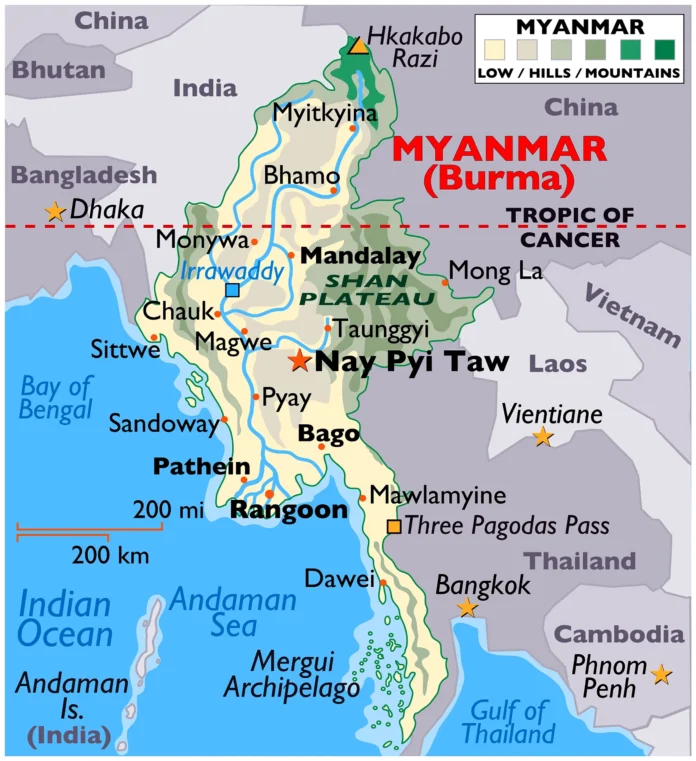India’s Northeast holds immense strategic importance, serving as a cultural and economic bridge between India and Southeast Asia. The region is endowed with vast natural resources and immense talent across multiple domains. However, it has also been plagued by insurgencies, ethnic strife, illegal migration, and security challenges. Despite several government initiatives, these issues have hindered the region’s development and stability.
The ongoing strife in Myanmar has further escalated security concerns in India’s Northeastern states, creating complex challenges for national security and regional stability.
Strategic Importance of India’s Northeast
The Northeast shares international borders with China, Myanmar, Bangladesh, Bhutan, and Nepal, making it a crucial part of India’s strategic security framework. The region is also integral to the success of India’s Act East Policy, which aims to enhance economic and strategic ties with Southeast Asia.
However, insurgencies, drug trafficking, illegal arms trade, and demographic shifts due to illegal migration have created long-standing challenges. The situation in Myanmar has further worsened the security landscape in the region, necessitating a robust response from the Indian government.
Impact of the Myanmar Crisis on Northeast India
1. Rise in Illegal Migration
The military coup in Myanmar in February 2021 and the subsequent civil unrest have triggered large-scale displacement of people. Thousands of Myanmar nationals, including members of the Chin community, have sought refuge in the bordering states of Mizoram and Manipur. While India has cultural and ethnic ties with these refugees, their influx raises security concerns, as unchecked migration can lead to demographic shifts and increased competition for resources.
2. Insurgent Activities and Cross-Border Terrorism
The political instability in Myanmar has created a power vacuum that several insurgent groups from India’s Northeast have exploited. Militant outfits like the United Liberation Front of Asom (ULFA), People’s Liberation Army of Manipur (PLA), and National Socialist Council of Nagaland (NSCN-K) have used Myanmar’s unregulated border areas as safe havens for training and launching attacks on Indian security forces.
Myanmar’s internal turmoil has weakened the country’s law enforcement, making it easier for insurgents to operate freely. The Indian government’s counter-insurgency measures, including cross-border strikes in Myanmar, highlight the seriousness of the threat.
3. Smuggling of Arms, Drugs, and Human Trafficking
Myanmar is part of the infamous Golden Triangle, a major hub for drug trafficking. The instability in Myanmar has fueled the smuggling of heroin, methamphetamine, and synthetic drugs into Northeast India.
Additionally, the availability of illegal arms has worsened the security situation. Reports indicate that sophisticated weapons from Myanmar are making their way into the hands of insurgent groups in Manipur, Nagaland, and Assam.
4. Border Security Challenges
India shares a 1,643 km porous border with Myanmar, spanning Arunachal Pradesh, Nagaland, Manipur, and Mizoram. The Free Movement Regime (FMR), which allows people from border villages to travel up to 16 km without a visa, has been misused by insurgents and smugglers. In response, the Indian government has been considering tightening border controls and enhancing surveillance.
Government’s Response to the Crisis
1. Strengthening Border Security
The Assam Rifles and Border Security Force (BSF) have increased patrolling and surveillance along the Indo-Myanmar border. The Indian government is also working on border fencing projects to curb illegal crossings.
2. Diplomatic Engagement with Myanmar
India has adopted a balanced approach in dealing with Myanmar’s military junta and pro-democracy groups. While maintaining diplomatic ties with the ruling regime, India has also provided humanitarian assistance to refugees and ethnic groups affected by the crisis.
3. Counter-Insurgency Operations
The Indian Army and paramilitary forces have intensified counter-insurgency operations against militant outfits hiding in Myanmar. Joint operations with Myanmar’s military, such as Operation Sunrise, have successfully dismantled several insurgent camps along the border.
4. Socio-Economic Development Initiatives
The Indian government has been promoting developmental projects in the Northeast under initiatives like Bharatmala and North East Special Infrastructure Development Scheme (NESIDS). The objective is to counter insurgency through economic growth, providing better employment opportunities and infrastructure development.
The Myanmar crisis has deepened security challenges for India’s Northeast, exacerbating issues related to illegal migration, insurgency, arms smuggling, and drug trafficking. However, India has been actively strengthening its border security, engaging diplomatically with Myanmar, and enhancing counter-insurgency operations.
While the security situation remains volatile, a comprehensive approach combining border management, military operations, and socio-economic development is crucial for ensuring peace and stability in India’s Northeast. The region’s strategic importance necessitates continued government focus, as its stability is directly linked to India’s national security and its vision for a stronger engagement with Southeast Asia.




